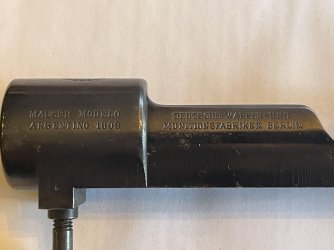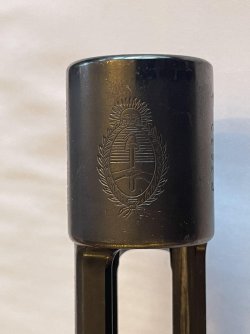specweldtom
Well-Known Member
First, there will be different opinions on what and how things need to be done, but these are things that I have done.
Buy a truing mandrell or fixture from Brownell's, or make one. I like the mandrell, and have made several out of old barrels. Take a light truing cut (or cuts) on the receiver face. Usually takes me about .006" - .008" to get one (Mauser) like I want it. Flat, square, and with a wider face for better make-up. I don't try to true the inner shoulder, because I want the outer to make up first Most of the books say to make up on the inner shoulder first, but I cut the tenon .001" short so the outer face will make up first. Once the barrel breech abuts the inner shoulder, make-up rotation stops cold, and I prefer that the outer shoulder be made up just before that happens.
Forge, or cut and weld the bolt handle to clear a scope. If you haven't done this, have someone you really trust to do it the way you want it. A good bolt can be screwed up if it's not done right. Next, drill and tap the receiver for scope bases. (I like 2 pc bases). Same precaution. I've seen too many receivers screwed up by off-center, off-spaced, out of line holes. Not a job for a hobbyist.
If you use the military bolt shroud, you'll need a scope safety. Buehler used to make them. If you find one of the nice commercial shrouds, they need a trigger with a side safety.
As for where to spend money, go for a high quality barrel first. A Lilja stainless barrel is my favorite.
Next, you need a good stock. For the money, a plain laminate stock from Stocky's is the best deal going. It will need to be pillar blocked and SteelBedded.
If they make them for large ring 98's, Bell and Carlson Medalist stocks are also good for the money, but for maximun accuracy, they need to be bedded also.
The standard military trigger can be modified to a clean, 3 - 4 lb, single stage let-off, but if you haven't seen one or done one, I don't recommend trying it. Get a fully adjustable Timney for about $100. It's a good buy, and is available with a side safety.
Scopes are the hardest to pick, and can be the single biggest expense on a build if you do the labor yourself. If you have to have the rifle built, the labor will cost more than a decent scope will. Don't expect much from a $100 Chinese scope, no matter what the brand name is. At around $250 you can start to get a pretty good scope. Watch for a Leupold or Nikon in that price range. I also think the SWFA Super Sniper at $300 is a good scope. It's a fixed power though.
Once you have all the pieces in hand or ordered, and know what they are going to cost, you can decide if you want to Parkerize or rustblue the action and floormetal. Parkerize (the dark manganese phosphate) looks good on a working gun. A nice rustblue is prettier though.
If you're patient, and can do the 'smithing yourself, you can build a fine 1/2 moa rifle for $1200.
Good luck, Tom
Buy a truing mandrell or fixture from Brownell's, or make one. I like the mandrell, and have made several out of old barrels. Take a light truing cut (or cuts) on the receiver face. Usually takes me about .006" - .008" to get one (Mauser) like I want it. Flat, square, and with a wider face for better make-up. I don't try to true the inner shoulder, because I want the outer to make up first Most of the books say to make up on the inner shoulder first, but I cut the tenon .001" short so the outer face will make up first. Once the barrel breech abuts the inner shoulder, make-up rotation stops cold, and I prefer that the outer shoulder be made up just before that happens.
Forge, or cut and weld the bolt handle to clear a scope. If you haven't done this, have someone you really trust to do it the way you want it. A good bolt can be screwed up if it's not done right. Next, drill and tap the receiver for scope bases. (I like 2 pc bases). Same precaution. I've seen too many receivers screwed up by off-center, off-spaced, out of line holes. Not a job for a hobbyist.
If you use the military bolt shroud, you'll need a scope safety. Buehler used to make them. If you find one of the nice commercial shrouds, they need a trigger with a side safety.
As for where to spend money, go for a high quality barrel first. A Lilja stainless barrel is my favorite.
Next, you need a good stock. For the money, a plain laminate stock from Stocky's is the best deal going. It will need to be pillar blocked and SteelBedded.
If they make them for large ring 98's, Bell and Carlson Medalist stocks are also good for the money, but for maximun accuracy, they need to be bedded also.
The standard military trigger can be modified to a clean, 3 - 4 lb, single stage let-off, but if you haven't seen one or done one, I don't recommend trying it. Get a fully adjustable Timney for about $100. It's a good buy, and is available with a side safety.
Scopes are the hardest to pick, and can be the single biggest expense on a build if you do the labor yourself. If you have to have the rifle built, the labor will cost more than a decent scope will. Don't expect much from a $100 Chinese scope, no matter what the brand name is. At around $250 you can start to get a pretty good scope. Watch for a Leupold or Nikon in that price range. I also think the SWFA Super Sniper at $300 is a good scope. It's a fixed power though.
Once you have all the pieces in hand or ordered, and know what they are going to cost, you can decide if you want to Parkerize or rustblue the action and floormetal. Parkerize (the dark manganese phosphate) looks good on a working gun. A nice rustblue is prettier though.
If you're patient, and can do the 'smithing yourself, you can build a fine 1/2 moa rifle for $1200.
Good luck, Tom


